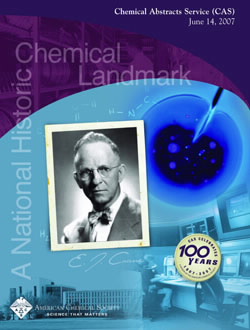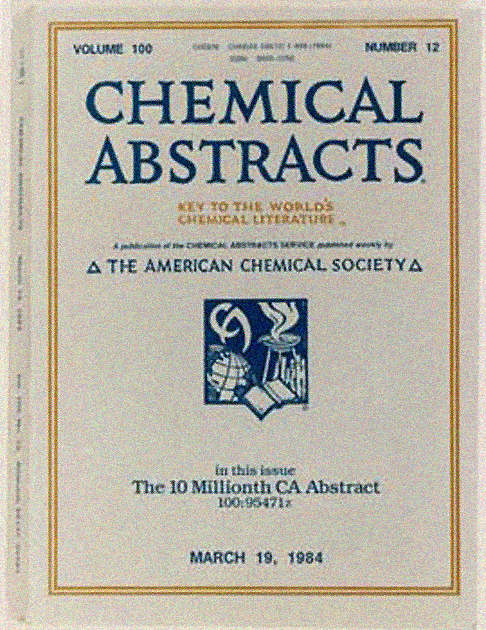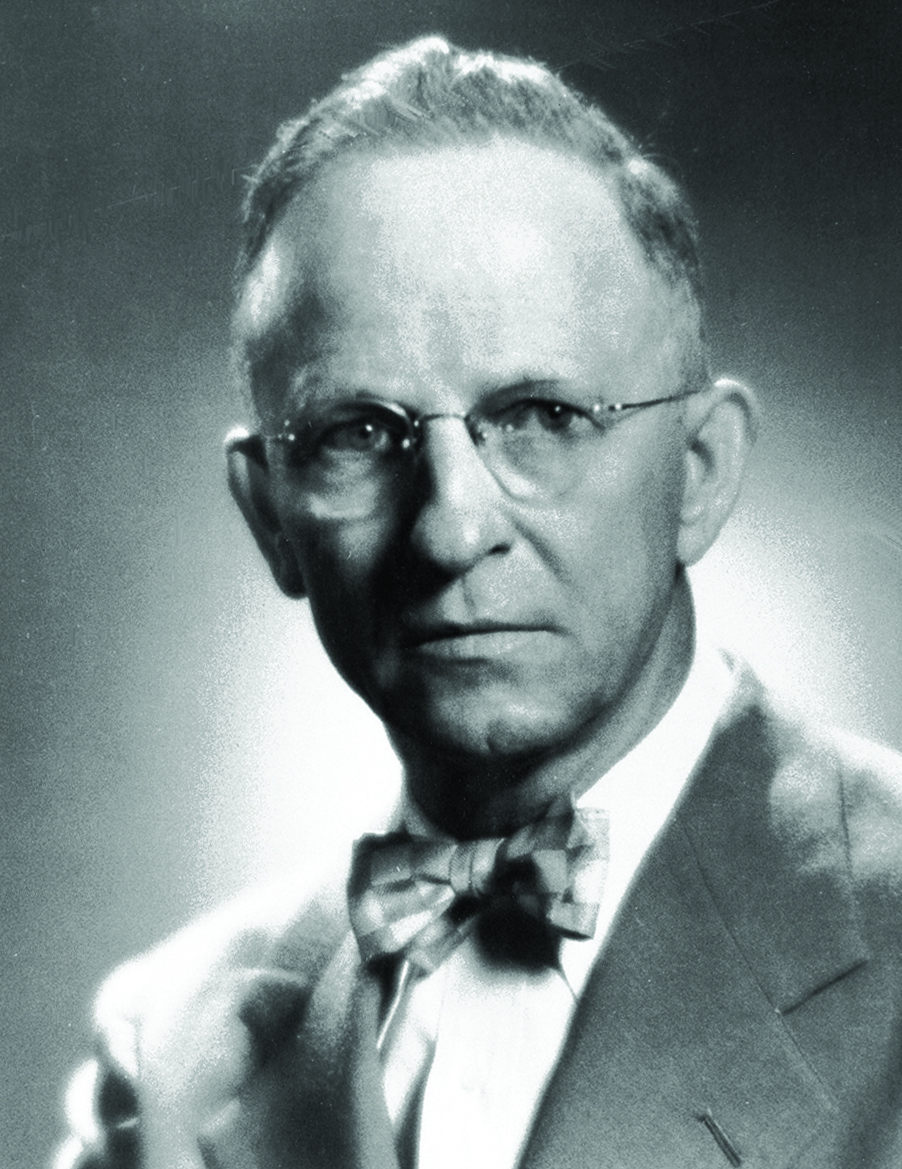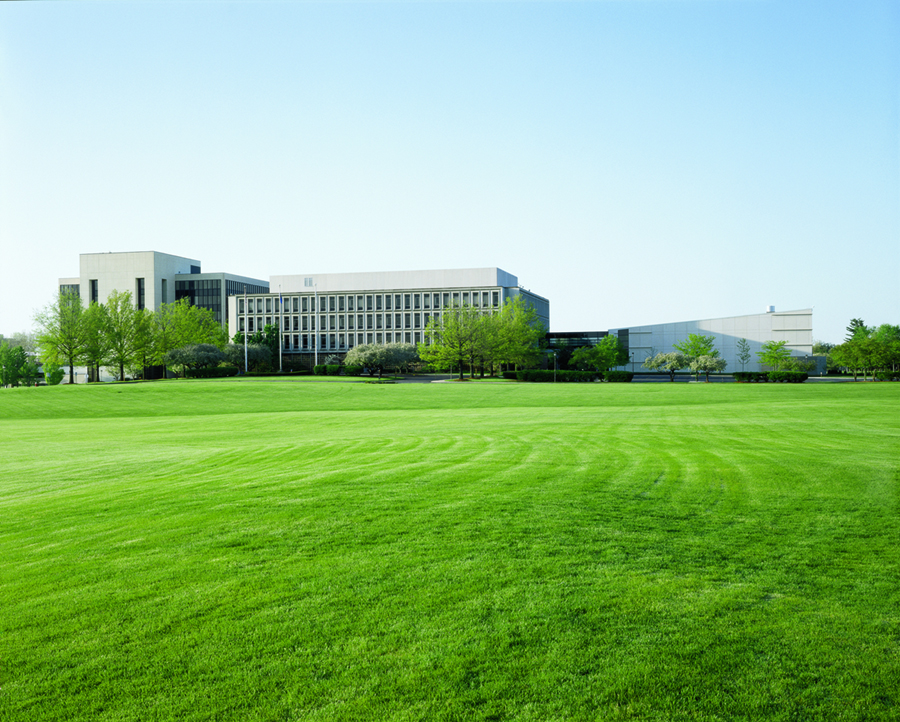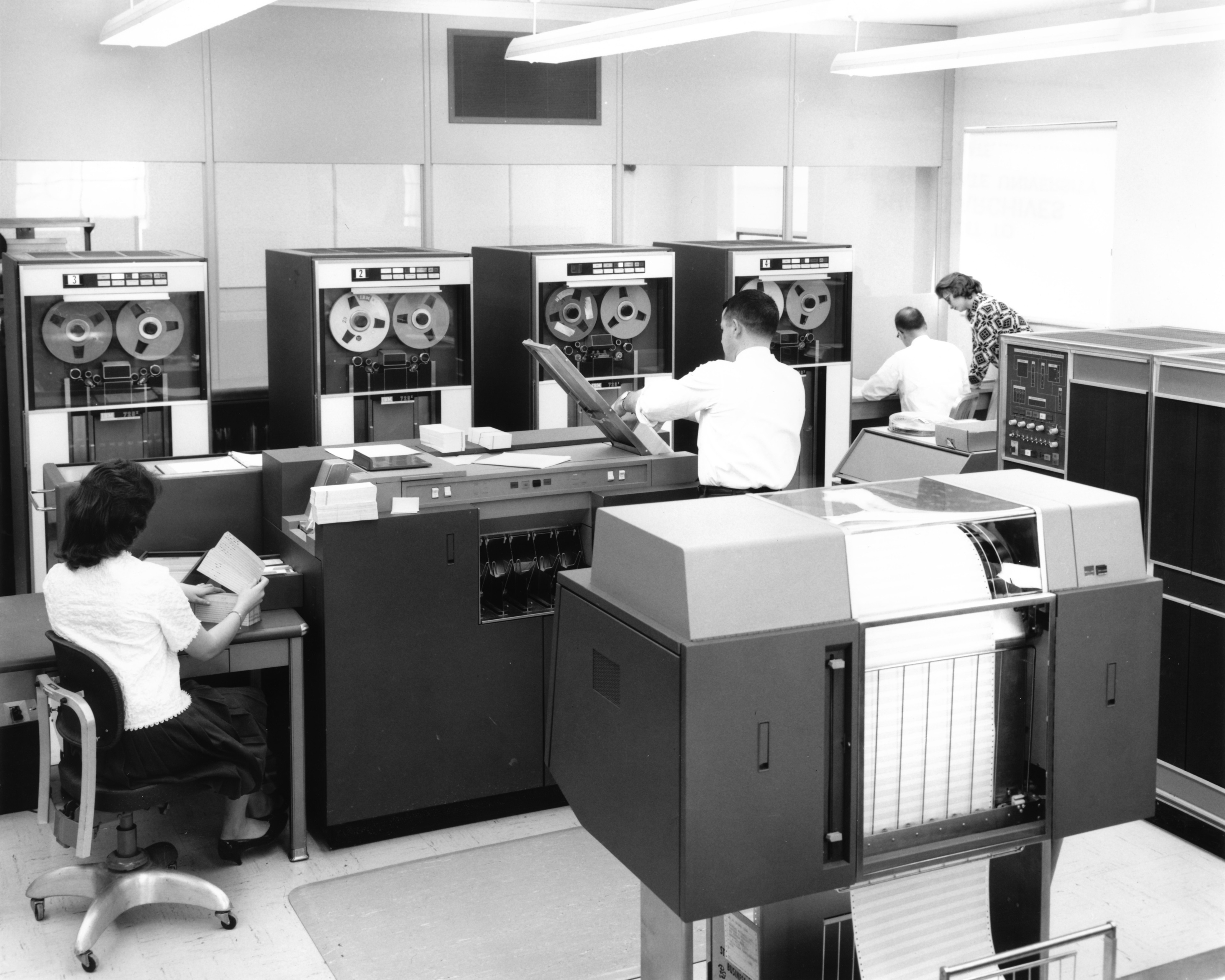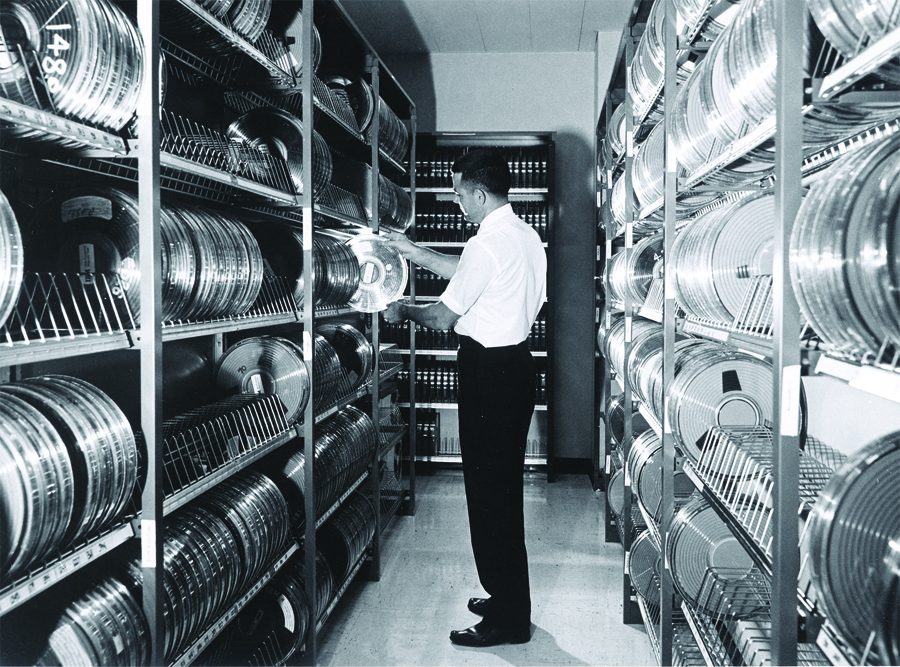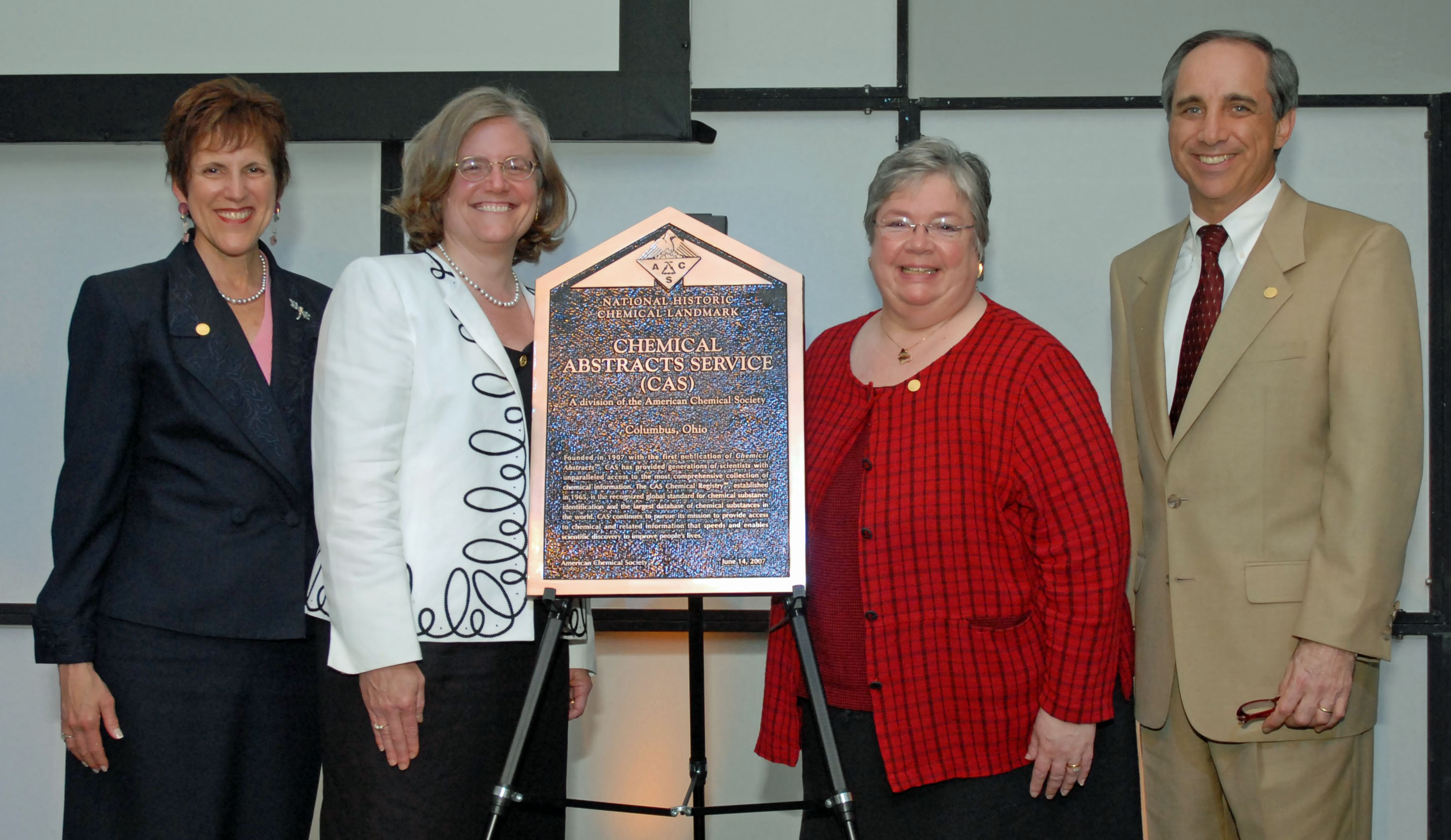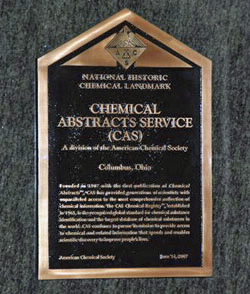Chemical Abstracts Service
Dedicated June 14, 2007, at the Chemical Abstracts Service in Columbus, Ohio.
The Chemical Abstracts Service, a division of the American Chemical Society, has provided the most comprehensive repository of research in chemistry and related sciences for over 100 years. CAS innovations have fueled chemical research through development of the CAS RegistrySM and CAS databases which contain invaluable information for chemical scientists, including SciFinder® and STN®.
Contents
Early Chemical Abstracting in the United States
The early history of chemical abstracting in the United States is intertwined with the Noyes family. In 1895, Arthur A. Noyes, a professor of physical chemistry at the Massachusetts Institute of Technology, began the Review of American Chemical Research (the Review) as a supplement to MIT's Technology Quarterly. He began the Review because he believed American chemists were not receiving adequate credit in European publications for their accomplishments, and under his editorship, the Review published only abstracts of American chemical papers.
In 1897, the Review became part of the Journal of the American Chemical Society (JACS). Five years later, William A. Noyes, Sr. (Noyes), a distant cousin of Arthur A. Noyes, became editor of JACS and the Review. Noyes long believed that the American Chemical Society should publish a comprehensive and inclusive separate journal of abstracts. He worked diligently to persuade the Society to authorize an abstract journal, and in 1906, the ACS Council approved publication of Chemical Abstracts, with Noyes as editor. The first issue appeared in January 1907.
Chemical Abstracts was not the first publication to abstract chemical information. Scientific abstracts first appeared in primary journals, which published abstracts of work reported in other sources in addition to original research. One example was the Philosophical Transactions of the Royal Society. The first specifically chemical publication to include abstracts was Crell's Chemische Journal fÜr die Freunde der Naturlehre, which was published from 1778 to 1781. Other German publications appeared in the late 1700s as a forum for chemists to exchange information and research. French (Annales de Chemie) and British (Journal of the Chemical Society) publications followed suit in the next century.
At the same time, publications specifically devoted to chemical abstracts began to appear. The most famous of these was Chemisches Zentralblatt, which debuted in 1830. It was published weekly under the editorship of Gustav Theodor Fechner. Chemisches Zentralblatt initially covered only German literature, and while it expanded its coverage in the early 20th century, the emphasis was always on German material. Chemisches Zentralblatt remained an important abstracting service until World War II. It was the emphasis on German chemistry that prompted the interest in an American abstract service.
Noyes served as editor of Chemical Abstracts for its first two years. At first, Noyes worked from his laboratory at the National Bureau of Standards in Washington, where he was chief chemist. He and Chemical Abstracts moved to the University of Illinois when Noyes became chair of the chemistry department there in 1907. Noyes’ contribution to the success of Chemical Abstracts cannot be exaggerated. Not only did he persuade ACS to sponsor an abstract journal, but he organized, planned and edited the publication while serving as ACS secretary and working full time. Many of the policies he implemented served Chemical Abstracts for decades.
One of Noyes's most important legacies was his insistence that Chemical Abstracts cover applied as well as theoretical chemistry. In the early 20th century the gulf between industrial and academic or theoretical chemists was wide and many of the latter thought that ACS, and its publications, should belong to "pure" chemists only with applied chemists shunted off to a separate organization. In England and Germany chemists split along these lines and in both countries distinct abstract journals existed. Chemical Abstracts pioneered in the merging of the interests of these two groups of chemists.
In 1909 Austin Patterson succeeded Noyes as editor, and the editorial offices moved to The Ohio State University (OSU) in Columbus at the invitation of William McPherson, head of the OSU Chemistry Department. Chemical Abstracts remained at Ohio State until 1965, when the Chemical Abstracts Service moved into its own building on a 50-acre site adjacent to the university.
The mission of CAS is to be the world's leading provider of chemical information."
— Robert J. Massie, President, CAS
(Quoted in Ross, Linda Romaine, "CAS Aims to Keep Customers by Improved Service, Pricing, Management," Chemical & Engineering News 72 (October 31, 1994): 20.)
Growth of Chemical Abstracts
The early history of Chemical Abstracts is the story of Evan J. Crane, who served as editor for 43 years. Crane succeeded John Miller, editor for a brief time in 1914 following Austin Patterson's resignation. Crane joined Chemical Abstracts in 1911 at the age of 22 as an associate editor; he became acting editor in 1915 after Miller’s resignation.
During Crane's stewardship, Chemical Abstracts grew from a fledgling operation into the trendsetter for scientific abstracting and indexing journals. Crane did this through some very difficult times—money was often so scarce that he dipped into his own small salary for business travel. Crane himself wrote that it was his "long-established policy to trim his budget sails as well as possible to fit the Society's current circumstances and then to keep within budget limits." During his tenure he did that, never exceeding the publication’s annual budget.
Crane said that "in times of financial difficulty, keeping within limits [was] accomplished principally by shortening abstracts rather than by failing to report all papers and patents containing new information of chemical interest. The history of Chemical Abstracts is in part a series of ups and down as far as length of abstracts is concerned, with most of the emphasis on 'downs.'" Crane's perseverance in the face of financial and other difficulties insured the success of Chemical Abstracts. He won many honors, including the Society's Priestley Medal, but perhaps Crane's greatest honor came in 1956 when he was named the first director of the renamed Chemical Abstracts Service (CAS), a new division of the American Chemical Society.
Under Crane's tutelage, Chemical Abstracts grew rapidly. In its first year of operation, 1907, the service published 12,000 abstracts. Half of those were on works published in Germany. The number of abstracts published rose almost every year after and the service soon claimed complete coverage of the chemical literature. Of course, the definition of "completeness" is itself abstract; as Crane wrote "completeness in an abstract journal is a somewhat indefinite goal never quite attained, but the whole history of Chemical Abstracts has been one of striving for complete coverage so that the user of this journal can have confidence in the thoroughness of his survey without searching elsewhere." He defined completeness as reporting all suitable papers and patents, insuring that each abstract is thorough to allow full indexing, and guaranteeing that the index contains all the useful information that a searcher needs.
Completeness meant, among other things, that the number of abstracts published each year soared. It was not until 1939—32 years after publishing began—that the number of abstracts published reached one million; it took eighteen years to generate the next million; eight years for the third million. In 2006, for the first time in one year, more than one million abstracts were added to the CAS databases.
Crane recognized early in his tenure that comprehensive and accurate indexes were necessary. Cursory author and subject indexes were provided from the beginning, but Crane undertook to release a thorough Chemical Abstracts Decennial Index in 1916, doing much of the work himself. This project prompted a search for a more thorough system of indexing. The solution was to devise a systematic index for compounds on the grounds that the absence of such a system would mean that references to compounds would be scattered throughout the index and related compounds would not be grouped together. The indexing system had an important influence on chemical nomenclature.
Over the years indexing assumed increased importance because of the volume of material being abstracted. An annual formula index was added in 1920. Other indexes were added: for example, numerical patent indexes and a keyword subject index. The amount of material abstracted became so large that in 1962 Chemical Abstracts began publishing Volume Indexes semiannually rather than annually.
CAS Expansion: 1950’s and 1960’s
Crane retired in 1958. He was replaced by Dale Baker, who became Director, while Charles Bernier was appointed Editor and Leonard Capell, CAS' nomenclature expert, was named Executive Consultant. The most important task facing these three men was to oversee CAS' transition from an ACS-supported service to a financially independent operation. In the beginning, ACS-member dues financed Chemical Abstracts and Society members could receive it free. In 1933 a small subscription fee was charged, as a supplement to the allocation from dues, a system that satisfied CAS' financial needs for a time.
After World War II, this financial arrangement proved inadequate. The rapid expansion of scientific publications—which meant more abstracts—coupled with post-War inflation forced CAS to look elsewhere for funding. For a time, industry was asked to make up the service's deficit. In 1955, the ACS Board of Directors stepped in and changed subscription prices with the aim that Chemical Abstracts should break even. Fees were raised so that, in the words of Board Chair Ernest Volwiler, Chemical Abstracts would become "a joint responsibility of the profession and of those governmental, industrial, and commercial organizations that have a direct stake in its availability."
The post-Crane leadership had a second problem to tackle—housing for a rapidly expanding organization. Since 1909, CAS had been housed on the OSU campus, first in a 15-by-30 foot room, then a room twice that size, and in 1928 in 1,600-square foot section of McPherson Chemistry Laboratory. In the 1950s, when CAS had a staff of 100, a building jointly financed by ACS and OSU was erected on campus to house the abstract service. In 1965—now with a staff of 300—CAS moved into a four-story, multi-million dollar building of its own on a 50-acre site adjacent to OSU's campus. Less than a decade later CAS added a second building.
Until the 1960s, Chemical Abstracts relied on volunteers for the bulk of its abstracting. In 1907, Chemical Abstracts utilized 129 volunteer chemists; by the mid-1960s the number of volunteers reached more than 3,200. Crane referred to some of the volunteers as "the iron men of CA [Chemical Abstracts]," and many served for decades, with thirteen volunteers abstracting for more than 50 years. Over the years the abstractors took on an international caste as chemists from 70 nations contributed entries. In the mid-1960s, CAS began to phase out its use of volunteers, and in 1994 it entirely ceased using volunteer abstractors.
Digital Age and Computer-enabled Abstracting
The decline in use of volunteers corresponded to CAS' entry into the digital age. Baker and the rest of the CAS leadership understood the need to modernize procedures due to the vast increase in chemically-related published material. Older methods for producing abstracts did not suffice by the 1960s. On one level, this meant professionalizing of the staff; at another, it meant new ways of processing information.
CAS had been moving into the information age slowly. In 1955 it established a research and development department. In 1959 Baker hired G. Malcolm Dyson, an Englishman who had worked on an early linear notation system for representing chemical structures. It was Dyson—working part-time in Columbus from 1959 to 1963—who developed many of the cutting-edge innovations in information processing that CAS introduced in these years, starting with Chemical Titles in 1961. Chemical Titles was the first periodical to be organized, indexed and composed by computer, which meant greater publishing speed. The issue of Chemical Titles listing a given article often reached subscribers before the journal in which that article appeared.
CAS information needs began to drive the technology. For example, CAS required a composition system that did not yet exist. This problem was solved in 1967 when CAS acquired an IBM unit and then developed a software-based, computer-driven composition system for it. It was put to good use, and by 1970 all Chemical Abstracts indexes were being organized and composed by computer. Computerization meant considerable savings in staff time and costs. It also meant more precise data; in addition, staff no longer had to do the routine fact checking which could now be done by the computer. This freed staff for the more intellectual tasks of analyzing the primary chemical literature. For chemists, it meant ease and speed. Information seekers in the past might have to wait a day or more for a librarian to find the appropriate references (only to find sometimes that the references were not appropriate). With computers, the chemist could do his own searching and do it quickly and accurately.
CAS revenues sources shifted with computerization. In 1975 95% of CAS' revenues came from print services; only 5% from electronic sources. By the end of the 20th century, that had shifted to 19% of revenues from printed sources with 79% from electronic services (the remaining 2% came from consulting and other sources). In 2006 95% of CAS' revenue stream derived electronic sources with the remaining 5% from print and other services.
The CAS Registry
The mechanization of information yielded CAS' most significant and far-reaching innovation: The Chemical Registry System. G. Malcolm Dyson first suggested the idea of a registry in the late 1950s. With the increasing complexity and sheer numbers of substances appearing in the literature, CAS needed an alternative to chemical nomenclature as a basis for this registry.
Chemists have an advantage over many other scientists in being able to communicate by referring to chemical compounds through unambiguous and universally understood structural diagrams. These diagrams indicate a compound's chemical atoms, the bonds that connect them, and even the spatial arrangement of the atoms. But there was no good way to catalogue these structures that enabled easy retrieval. At CAS, every time a chemical compound was indexed it was copied by hand and then given a name, which may or may not have agreed with the name given it by its presumed discoverer. Was the compound really new? Had it been reported in the literature? Indexed by Chemical Abstracts? The rapid increase in the number of named structures led to much confusion; some compounds were named over and over.
Clearly, CAS needed a system that recognized previously named structures and allowed for easy retrieval by CAS staff. In the early 1960s a solution was found when Harry Morgan of CAS developed an algorithm that generates a unique and unambiguous two-dimensional record of a substance's structure. The record could be read by a computer and was so simple that staff with little special training could employ it. The algorithm became the basis of the CAS Chemical Registry System (CAS Registry).
In late 1964 an experimental Chemical Registry System went into operation supporting the new publication Chemical-Biological Activities. By early 1965, the CAS Registry, no longer experimental, began to include all chemical substances indexed in Chemical Abstracts, with their structures and names recorded in computer-readable files. Every substance was given a permanent, unambiguous and unique identifying number, the CAS Registry Number.
To show the usefulness of the CAS Registry to researchers, think about a hypothetical new drug developed by a pharmaceutical company. This drug could have a systematic chemical name about 70 characters long, and be marketed under several different trade names. But it can be identified concisely by CAS Registry Number of up to 10 digits, such as 58-08-2 for caffeine. Today scientists and researchers around the world rely upon the CAS Registry Number as the globally accepted standard for defining and describing a chemical substance.
Though the system would go through several iterations over the years, it quickly became an integral part of CAS’s indexing procedures. More advanced versions were soon added which refined and improved nomenclature and the ability to recreate structure diagrams algorithmically. It took only ten years for the Registry to record three million unique structures. But the Registry's virtue is not limited to size or number; its success has eliminated the vagaries of chemical nomenclature since every unique substance gets a unique CAS Registry Number.
Online Abstracting Tools: STN, SciFinder, and More
In the 1970s and 1980s the Chemical Abstracts Service adopted the tools of the new digital age—the computer, the internet, etc.—to assist CAS in fulfilling its core mission: Providing scientists with access to chemical literature and information. What changed were the methods of delivery (away from paper and traditional forms of publishing) and the speed with which CAS was able to deliver information to clients. In the past, chemists needing information might have to wait a day or several days for a librarian to find the requested references, which might not be entirely relevant. But in the digital age, scientists are only seconds from the information sought. Not only is information retrieval faster, but it can be done by the scientist himself.
CAS entered the electronic information age slowly. Before the 1980s online access to CAS databases went through commercial vendors. On November 1, 1980, CAS introduced CAS ONLINE®, which provided access to about one-third of CAS's substance records. Gradually, other segments of the CAS Registry were added as search capacity increased. Although initially limited, CAS ONLINE® permitted bench chemists and information experts to identify substances by specified molecular structures, something difficult, if not impossible, to do with printed materials. Although searching has been augmented over the years and the display of CAS Registry records has improved, the most remarkable advantage researchers derive from CAS ONLINE® remains the ability to perform structure-based searching of the CAS database.
In 1983 CAS introduced CA File, which enabled subscribers to retrieve post-1967 bibliographic references. Other enhancement followed, but by the 1980s CAS began planning a new online network, one that grew out of an agreement between the American Chemical Society and the German scientific organization, FIZ Karlsruhe, to create an international network of databases to include areas beyond chemistry and chemical engineering. The result was STNSM International—the Scientific and Technical Information Network.
STN® offered access to CAS files and Physics Briefs. Initially, the creation of STN® provided European customers access to CAS files and search systems. Eventually, CAS databases would become available globally. As the CAS web site puts it: "STN® is an online database service that provides global access to published research, journal literature, patents, structures, sequences, properties, and other data."
Dale Baker, who had ushered CAS into the digital age, retired in 1986 after serving as director for 28 years. Ronald Wigington, who had been director of research and development, succeeded Baker as director with no change in the emphasis on moving CAS toward the delivery of electronic information services. Wigington left in 1991 and was replaced a year later by Robert Massie.
Massie's first challenge was to insure CAS' financial well-being. At the same time, he wanted to guarantee CAS' leadership in providing scientific information. To further the latter, CAS moderated its price increases—to keep old and attract new customers—and strengthened product development. This meant even greater emphasis on electronic services in the 1990s as CAS embraced the Internet and World Wide Web as tools for distributing information. In 1995 CAS introduced CAplusSM, a database covering literature worldwide in chemistry, chemical engineering, biochemistry and related sciences since 1967.
A major launch in the 1990s was SciFinder®. Much research went into the development of this forward-looking tool. Although the Internet was still in its infancy, CAS recognized the need for a new mode of data searching and retrieval. The rapid increase in personal computers meant that it would be possible to put chemists in direct connection with CAS databases. In 1991, CAS began to look into creating a desktop research tool, and the next year created a product development team. This group solicited views from CAS staff members and from customers. From users, the CAS researchers learned that scientists wanted more control over research and direct access to information. Moreover, the team understood that most scientists were not familiar with the language of information retrieval; accordingly, the search mechanisms had to be conversational and intuitive. In other words, users should not be asked to learn a command language, but rather they should be able to sit at their computer and use the system without training.
After extensive testing of prototypes by pharmaceutical and chemical companies, SciFinder® was launched in 1995. From the beginning it allowed for simple interaction with the search system. The complex algorithms and other tools that buttress the CAS Registry and other CAS files remain in the background. In 1997 SciFinder® ScholarTM appeared as a version of SciFinder® for chemistry students and faculty.
CAS quickly adapted to the online environment as it became popular in the closing years of the 20th century. Web-based initiatives undertaken by CAS included creation in 1994 of its website, http://www.cas.org; introduction of Chemical Patents Plus in 1996, which covers U.S. patents since 1974; STN® Easy, also in 1996, to make access to some STN® databases even easier; ChemPort® in 1997, a joint service with ACS Publications to provide links from the records in the searchable databases to full-text journals and patents on the Web; a whole host of new STN® products, including STN® Express™, STN® AnaVist™, STN® on the WebSM; and many others.
By 2007, when CAS celebrated its 100th anniversary, its databases demonstrated the exponential growth in scientific publishing and research. Those databases contained more than 27 million records of journal and patent literature, more than 170 million citations and more than 30 million substance records in the CAS Registry. In the words of Robert Massie, "CAS celebrates one hundred years of service to world science as an integral part of the American Chemical Society. That is a century in pursuit of a single mission—to provide access to chemical and related information that speeds and enables scientific discovery to improve people's lives."
Landmark Designation and Acknowledgments
Landmark Designation
The American Chemical Society designated the Chemical Abstracts Service a National Historic Chemical Landmark in a ceremony at CAS headquarters in Columbus, Ohio, on June 14, 2007. The text of the commemorative plaque reads:
Founded in 1907 with the first publication of Chemical AbstractsTM, CAS has provided generations of scientists with unparalleled access to the most comprehensive collection of chemical information. The CAS Chemical RegistrySM, established in 1965, is the recognized global standard for chemical substance identification and the largest database of chemical substances in the world. CAS continues to pursue its mission to provide access to chemical and related information that speeds and enables scientific discovery to improve people's lives.
Also on June 14, 2007, the American Chemical Society presented a plaque to The Ohio State University for its support of CAS, which was located on the OSU campus for many years. The text of the plaque presented to OSU reads:
From 1909 to 1965, The Ohio State University provided the American Chemical Society a range of support services and facilities that allowed the nascent Chemical AbstractsTM publication to grow into the world's most important resource for chemistry-related research. CAS moved to its own campus in 1965, adjacent to The Ohio State University, and cherishes the memory of that half century of generous and farsighted support.
Acknowledgments
Adapted for the internet from “Chemical Abstracts Service (CAS),” produced by the National Historic Chemical Landmarks program of the American Chemical Society in 2007.

